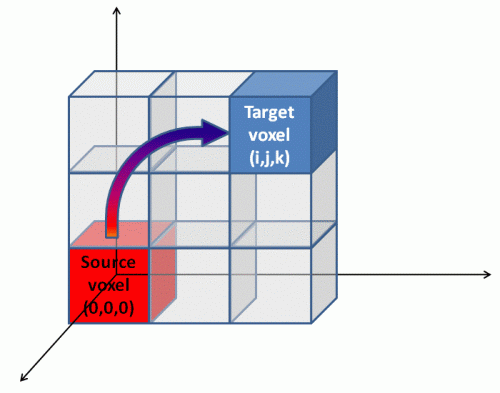Voxel dosimetry in Nuclear Medicine
Voxel dosimetry can be defined as the calculation of radiation absorbed dose to tissue regions with dimensions ranging from hundreds of micrometers to a few centimeters. Voxel dosimetry is generally associated with tomographic imaging or autoradiographic techniques for activity quantification. This level of dosimetry is of particular interest in applications such as radioimmunotherapy with radiolabeled monoclonal antibodies, radiotherapy of carcinomas, and intratumoral injection of therapy radiopharmaceuticals.
In most clinical trials and therapeutic applications, the basic formalism of the Medical Internal Dose Committee (MIRD) of the Society of Nuclear Medicine has been used. This formalism is based on the use of radionuclide specific S values defined as the mean absorbed dose to a target organ per radioactive decay in a source organ. The use of standard anatomic models and S values at the organ level is the major limitation of this approach. Dosimetric results can be assessed only in terms of mean absorbed dose to the organ; moreover, tumor dosimetry is not included in the model. However, there is nothing intrinsic in the MIRD schema that precludes its extension to take into account nonuniform source distributions. With this aim, MIRD Pamphlet No. 17 has introduced voxel dosimetry to allow dosimetric calculations at the voxel level. The cumulative activity, defined also at the voxel level, can be derived from patient specific SPECT or PET image data. By using this approach, internal dosimetry should include patient-specific information and the distribution of the activity and the dose at the maximal experimental resolution to which the distribution of the radio tracer can be determined. The use of voxel S values as the method of choice for voxel dosimetry has been limited because of the lack of tabulated S values for different voxel dimensions and radionuclides. In fact, the voxel S values are currently available only for a limited number of radionuclides and voxel dimensions. Voxel S values can be calculated using direct Monte Carlo radiation transport simulations.
Here, we calculated S values at the voxel level for several voxel dimensions and various radionuclides, by means of Monte Carlo simulations. Electron and photon transports were simulated in two different homogeneous tissues: soft tissue, having the elemental composition and physical density defined by Cristy and Eckerman, and bone tissue (namely, compact bone), as defined by ICRU Report 10b. Dose to tissue is scored in grids of cubic voxels (target voxels), having the chosen voxel size, with the sources uniformly dispersed in a voxel irradiating isotropically the surrounding ones (source voxel). The centroid of the source voxel was assumed as the origin of the Cartesian system. We also compared results obtained by using differente Monte Carlo codes. More information are available in this paper.
The S values calculated for different radionuclides and voxel sizes can be downloaded here.







